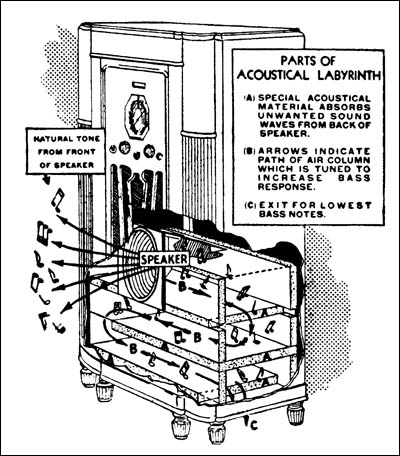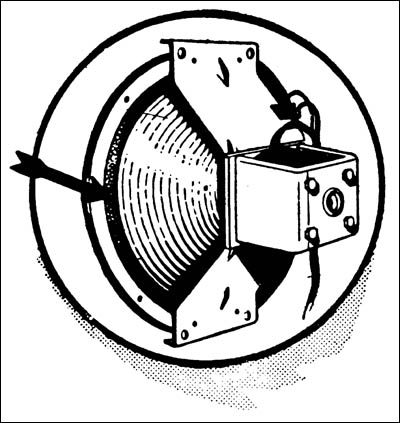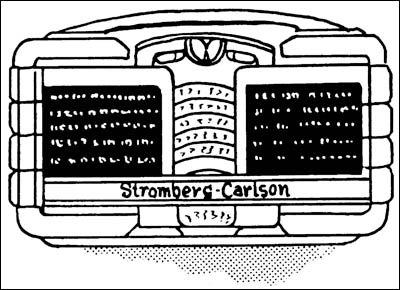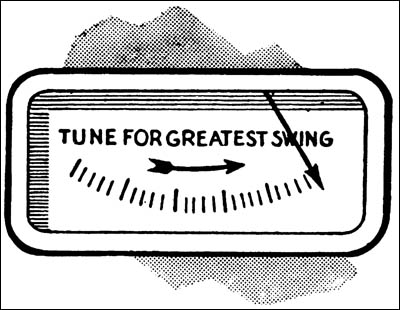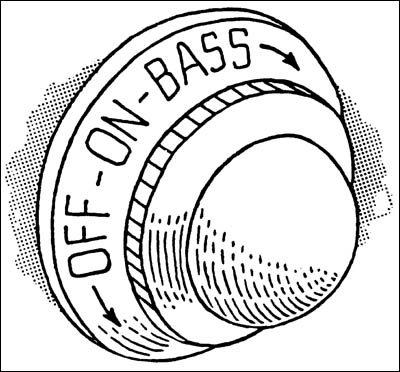Of Old Radios And Related Items--Published Monthly
How to Choose a Radio à la Stromberg-Carlson
BY DOROTHY SCHECTER FROM INFORMATION CONTRIBUTED BY BILL ALLEN
Web Edition
Vintage brochures are often sources of much information on antique radios and the sales techniques of their manufacturers. Two examples that were the subjects of articles in past issues of A.R.C. are Radiotron (June '04) and Day-Fan (January '05). Bill Allen's Stromberg-Carlson brochure offers more insight into the objectives of such an advertising piece. (Editor)
Sometime ago, Bill Allen sent us the 16-page, 1936 Stromburg-Carlson brochure which inspired this article. It reminded us once again of how early radio manufacturers used detailed sales pitches to attract customers. Obviously, they expected their audience to have long attention spans, and to be capable of understanding subtleties. How unlike our "soundbite" present.
This brochure's cover pictures a large console, but doesn't even name its manufacturer, Stromburg-Carlson. Instead, the title is "How to Choose a Radio." Yes, the approach is subtle, clever if you like. The reader is lured into justifying the purchase of a new radio, even though the old one runs perfectly well. Why should you make the purchase? Because in just a few years, your old set has become outmoded and offers none of the enhanced capabilities of the latest -- yes, of course, at last you know, along about page 6 -- Stromberg-Carlson!
Figure 1. Stromberg-Carlson states that "the Acoustical Labyrinth provides the greatest tone improvement in radio history."Sounds familiar, of course. But today, your computer, cellphone, Ipod, whatever, is outmoded almost overnight, and the pressure is on to get with the program without a moment's delay. There's a different tone in this brochure -- more measured, more cerebral, if you will, than anything you find in today's advertising outside of the technical journals.
Reasons to Update Your Set
If you are a potential buyer of something you already have that works like new, the manufacturers of yesteryear seemed to think you needed solid reasons to buy a newer model -- beyond a mere fashion trend. Those reasons are laid out for you in the first two pages of this brochure. Here's the pitch:
Figure 2. Stromberg-Carlson speakers use waterproof carpinchoe leather for edge suspension.First, you are told that key broadcasting stations are about to increase their power by 10 times more than the 10 times they've already increased it. Your set designed for a mere 5,000-watt broadcasting station won't be able to handle the new 500,000-watt transmissions efficiently.
Second, studios are now using high fidelity broadcasting equipment. Think of the pleasure you'll miss with this increased program sound range, if your set is designed for the old standard broadcasting equipment.
Third, there are new wave bands -- new channels of entertainment -- available in the new sets; for example, shortwave broadcasting for long distance, foreign reception, and better American summer reception; Amateur, police, aircraft, and ship-to-shore communications; and an extended regular broadcast band to include high fidelity broadcasting stations between 1,500 and 1,600 Kc.
Figure 3. The dial tells the whole story.The list of improvements goes on. The "boom" of cabinet cavity resonance has been removed by acoustic engineers. New materials greatly increase the efficiency of speakers. New tubes, larger dials and improved methods of visibly running and controlling radios are present in new models. Furthermore, cabinet design, finish and construction have taken giant steps in even recent months.
How to Choose Your New Radio
The patient shopper for a new radio must now be convinced that his set is outmoded. Still, he has reached pages four and five of this booklet and no specific set or manufacturer has been mentioned. But, soon he will be instructed about what to look for, and, of course, he will find that only Stromberg-Carlson has all the necessary attributes.
The first and most important of these attributes is "Natural Tone" -- the pitch tones and overtones of speech and music. The buyer is advised to listen to a symphony orchestra program to see if he can identify individual instruments and thereby hear their true harmonics reproduced. Speaking voices too should have no distortion or exaggeration; announcers should sound as natural as if they were in the room with you.
Figure 4. Tri-Focal Visual Tuning Indicator.Avoid radios that add tones of their own to distort percussion sounds, such as drums, plucked strings, or the hammer blow on a piano note. Test the tonal balance between bass and treble notes. In short, a buyer should be a wary acoustician.
How to meet this and other requirements for perfection in a console? On page six, Stromberg-Carlson finally identifies itself and begins to supply answers.
The first is its patented "Acoustical Labyrinth," shown in Figure 1, which is a set of large baffles, folded within the cabinet, filling the cavity that caused boom, and mixing the tones properly. This exclusive Stromberg-Carlson feature utilizes fully the power of the new Beam Power tubes that greatly increase the undistorted volume or power of the radio.
Second is the importance of speakers in producing "Natural Tone." Stromberg-Carlson manufactured its own dynamic speakers, thus assuring uniformity of results. Big, oversized speakers are not the answer, as some other manufacturers claim. Instead, the best size is approximately 10" in diameter, not too heavy in the voice coil and the diaphragm to reproduce treble tones accurately, and not too small to push enough air to generate adequate bass response. Figure 2 shows the Stromberg-Carlson speaker.
The use of soft, extremely flexible carpinchoe leather as edge suspension made the speakers vibrate more uniformly and easily than any other method yet devised. Furthermore, carpinchoe leather is unaffected by moisture, and it is important that the speaker cone be made of water-proofed material not affected by climatic conditions.
Real High Fidelity and More
The brochure warns that the radio the buyer chooses must be able to reproduce real high fidelity, defined as the reproduction of certain musical tones not otherwise heard; that is, an extended treble range or, simply put, more high notes. This Stromberg-Carlson does that with hi-fi radios that reproduce, without distortion, treble frequencies as high as 7500 cycles or more. These frequencies can be adjusted to musical tastes with fidelity and tone controls.
Figure 5. Meter Tuning.The buyer is charged with testing a number of other qualities before his purchase is made. Among them are selectivity, sensitivity, an automatic volume control, the volume itself, the antenna system, the ease of tuning, tuning ranges, visual tuning, dual speed tuning, easy to identify knobs, and a rigidly built chassis.
Selectivity. A properly constructed set should be able to tune in a distant station while a local station is broadcasting on a nearby wave length. Stromberg-Carlson radios are designed to give adequate selectivity when the new high-powered stations are in operation. The use of multiple gang condensers, iron-core intermediate frequency transformers and double intermediate frequency amplification makes this possible.
Sensitivity. The larger Stromberg-Carlson radios employ 4-gang tuning condensers with double preselection for full sensitivity and adequate selectivity at all times. For shortwave reception, where local station interference does not exist, Stromberg-Carlson radios automatically permit full sensitivity on the shortwave services.
Figure 6. Easy to Identify Knob.Automatic Volume control. You do not want to have to adjust the volume control every time you shift from a strong to a weak station, or vise versa. You do not want music that is strong one moment and fades out the next. Stromberg-Carlson radios incorporate an efficient Automatic Volume Control -- some, indeed, offer a Double Automatic Volume Control.
Volume. It is a good idea to test the volume from a whisper to the peak, to make sure that its gradation rises steadily without sudden jumps or surges. At maximum volume, there should be no distortion in the music or voices.
Antenna System. Even the best radios need the proper antenna system to avoid external noises and to insure best reception of both domestic and foreign stations. Using an old antenna on a new radio is like equipping a new automobile with old tires. The Stromberg-Carlson antenna is designed to fit the requirements of all broadcast shortwave radios, either high fidelity or standard.
Ease of Tuning. Stromberg-Carlson designs its own dials in exclusive styles. Selectorlite or color band indications tell at a glance which range is in use. Figure 3 shows the Stromberg-Carlson dial.
Tuning Ranges. There are Stromberg-Carlson radios that cover the American and Canadian standard broadcast bands, the new high fidelity stations, the regularly scheduled shortwave channels, as well as the service bands. Table 1 shows the available radio broadcast bands.
Visual Tuning. A means of visually tuning your radio to the peak position for best tone quantity is a distinct advantage. Stromberg-Carlson offers two efficient methods of visual tuning. Figure 4 shows the new Tri-Focal Tuning, so-called because it automatically adjusts its operation to strong, local, weak or medium signals. Meter tuning is also offered, as shown in Figure 5.
Dual Speed Knobs. For tuning foreign stations, a knob which permits slower, finer tuning is a distinct asset. Yet, the fast speed knob is desirable for broadcast tuning, and going from one band of shortwave programs to another. Stromberg-Carlson offers a "split" tuning knob whereby the base of the knob provides normal tuning and the tip of the knob gives slow-speed tuning.
East-to-Identify Knobs. Radios covering several wave bands, with the necessary high fidelity, tone and other controls, are hard to operate unless there is some means of recognizing the use of each knob. Insist on a radio that any guest in your home can easily understand and operate. On Stromberg-Carlson radios, the knobs are not only identified, but, through markings on them, it is easy to tell the exact setting in use.
Rigidly Built Chassis. All Stromberg-Carlson radios are constructed upon a rigid chassis base. As shown in Figure 6, they are permanently mounted on rubber with no screws of clamps to be undone before operation.
According to the brochure, Stromberg-Carlson has addressed all these areas with care and come up with a superior product.
Radio Phonographs
A short sales pitch is devoted to radio phonographs of two types -- those that play a single record and those that change a number of records automatically. Buyers are warned to take special care to watch how the record-changing mechanism handles the records. Stromberg-Carlson employs the new "Free-Floating Pickup Head" which handles records as if by hand. Of course, the company uses the same audio system and loud speaker as the radio.
Appearance and Cabinet Design
Finally, the buyer is advised to choose the Stromberg-Carlson cabinet design that best suits his home decor. At the same time, he will be getting a cabinet made of 5-ply, non-warping wood, which means long life and sturdiness to a set. A hand-rubbed lacquer finish also insures longevity. In addition, all Stromberg-Carlson sets have feet, thus preventing dust from gathering beneath them and keeping them from teetering on the edge of a rug.
Nothing Finer...
Summarizing the message of the brochure on the inside back cover is the slogan, "There is nothing finer than a Stromberg-Carlson." With all this information to go on, even the most skeptical buyer would have to assume that there's a measure of truth to this slogan.
Another interesting note: on the back cover of the brochure is a stamped name of a company that must have distributed the brochure in hope of selling Stromberg-Carlson sets: Noll Piano Co., 2205-7 S. Muskego Ave., Milwaukee, followed by "Mitchell 3533" -- Even the telephone number speaks to the good old days.
(Bill Allen, 505 South 8th St., Eldrige, IA 52748; Dorothy Schecter, c/o A.R.C., P.O. Box 2, Carlisle, MA 01742)
| [Free Sample] [Books, etc., For Sale] [Subscribe to A.R.C./Renew] [Classified Ads] [Auction Prices] [Event Calendar] [Links] [Home] [Issue Archives] [Book Reviews] [Subscription Information] [A.R.C. FAQ] URL = http://www.antiqueradio.com/Sep06_Schecter_Choose.html Copyright © 1996-2006 by John V. Terrey - For personal use only. Last revised: August 27, 2006. For Customer Assistance please contact ARC@antiqueradio.com or call (866) 371-0512 toll free Pages designed/maintained by Wayward Fluffy Publications
Antique Radio Classified |
